The Definitive Sennheiser E935 review
Does this dynamic vocal microphone really have the clarity and warmth of a studio condenser mic?

Reviewed by: Paul Narang
Review date: August 2022
Current price: Around $150
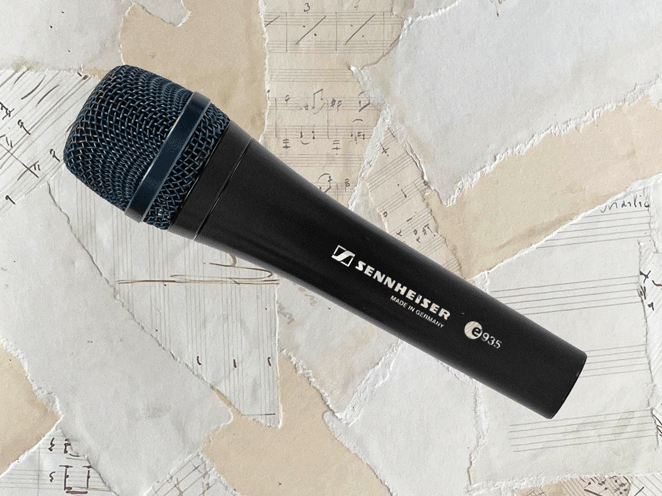

Sennheiser E935 Review
| Pros: | Cons: |
| Detailed and open sound Rugged construction Good side rejection | Possible sibilance on some voices |
Sennheiser E935 Review
An extended range dynamic vocal mic with a cardioid pickup pattern. This rugged microphone has a warmth and clarity ideal for live vocals. It minimises and rejects sound from the sides of the mic and keeps feedback to a minimum.
What is it?
Sennheiser are one of the most well known microphone manufacturers, with a professional user base across broadcast, live music and recording studios.
They bought out the high end Evolution 900 series to serve professional vocalists and musicians on the live stage. The collection of harmonically calibrated mics include three specifically for vocalists:
- Sennheiser E935 cardioid dynamic (reviewed here)
- Sennheiser E945 supercardioid dynamic
- Sennheiser E965 condenser
The E 935 is a metal bodied mic with a cardioid polar pattern. It’s designed to be hand held, with minimal handling interference. So how does it perform in our Sennheiser E935 review?
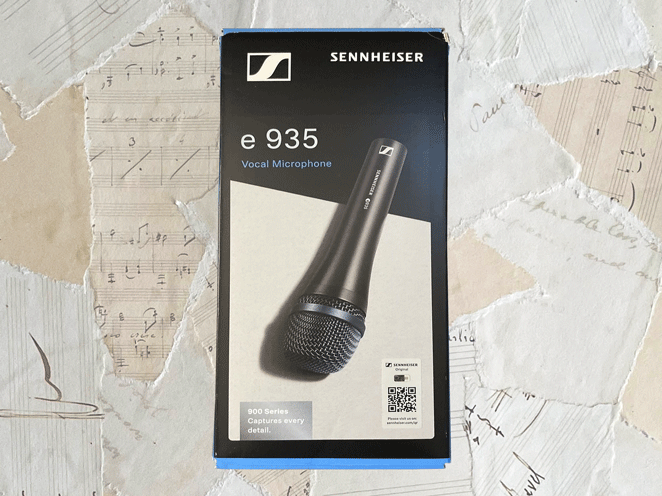
In the box
The Sennheiser E935 mic arrived in a smart blue, grey and white cardboard box which also included:
- microphone clamp
- Zip up microphone pouch
- User manual
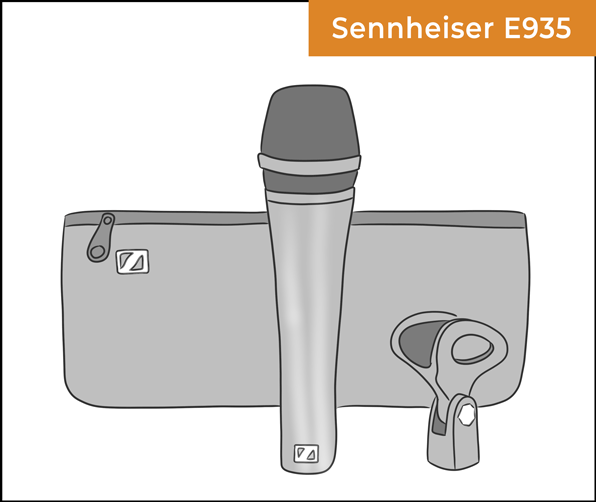
Dynamic vs condenser microphone
The Sennheiser E 935 is a ‘dynamic’ mic, making it particularly suitable for live use. Dynamic microphones differ to ‘condenser’ microphones in the following ways:
- They’re less sensitive (suitable for loud sounds)
- They’re less prone to feedback on stage
- They’re more rugged and durable for live use
- They’re cheaper
- There’s no need for batteries or phantom power
Dynamic mics in the home recording studio
Although dynamic mics are regularly used in live performance, they also have a unique place in the studio. The lack of sensitivity might sound like a drawback, but it can also work to your advantage.
A dynamic microphone, particularly one with a cardioid pattern, will pick up less of a poor sounding room, street sounds, or distant traffic rumble. It’s also the ideal choice for loud instruments such as drums and brass.
They also have their own tone, and can be used to tame shrill sounding instruments, or to add darkness and grit to overly bright vocals.
E935 Polar pattern
Like many dynamic microphones the Sennheiser E935 uses a cardioid pickup pattern, which is a heart shape. It picks up sound from the front, but rejects sound from the back and sides. This makes it ideal for use on stage, where you can isolate the vocals from other noisy instruments.
It’s also handy for the studio when you have 2 or more singers or instrumentalists recording at the same time.

No on/off switch on the E935?
None of the mics from Sennheiser’s 900 series have on-off switches. This keeps the design of the E935 as simple as possible, and minimises the chances of anything going wrong. If it’s important for you to be able to switch your microphone on and off, take a look at the E835 S, from the 800 series.
Phantom power for the Sennheiser E935?
The E935 is a dynamic mic, which means it doesn’t require any form of external power. There’s no need for batteries, or ‘phantom power’ from the audio interface or mixer.
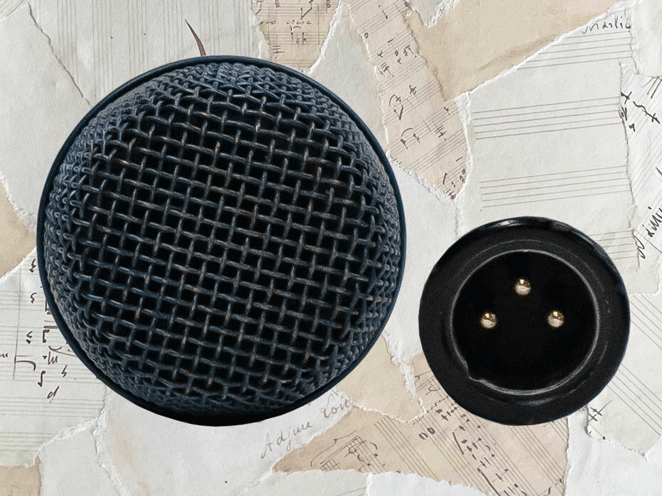
Connecting the Sennheiser E935
The E935 uses an XLR cable to connect directly to an audio interface or mixer. XLR are the standard connectors on all professional studio equipment. They’re ‘balanced’, which means the cables are shielded from interference and carry a higher signal than unbalanced cables.
If your audio interface or mixer has 1/4″ jack inputs, you’ll need a cable with an XLR connector on one end, and a 1/4″ jack on the other, like this. Keeping cable lengths to a minimum is good practice to maintain the best signal.
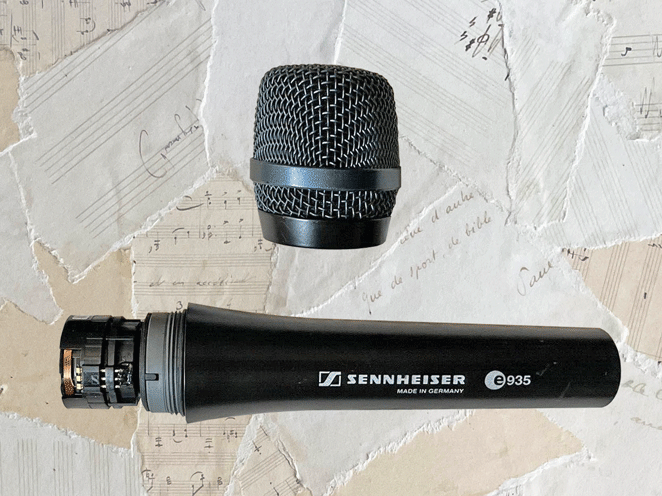
The Sennheiser E935 Design and build
The Sennheiser E 935 dynamic vocal mic is simply designed and ultra strong. It’s simplicity means there isn’t much to potentially go wrong during a live or studio session.
Like the other vocal mics in the Evolution range, the E 935 has an attractive, slender design. It has a good weight to it, at 355g (0.78 lb), and with a diameter of 47 mm (1.85″), fits snugly in the hand. The length is 151 mm (5.95″), which is slightly shorter than the Shure SM58.
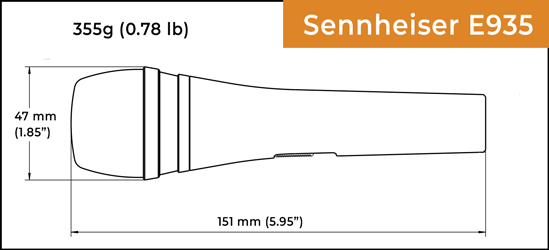
Reassuringly rugged, the main dark grey body is made of metal, and there’s a strong blue/black metal grille protecting the top. The grille can be unscrewed, so that the foam insert can be removed for cleaning or replacing.
Inside the mic is a humbucking coil, which effectively cancels electromagnetic hum, ensuring a clean signal. And an elastic capsule suspension isolates handling noise, so you can hold the mic with the confidence that it won’t interfere with the sound.
The E935 has a strong neodymium ferrous magnet which ensures microphone stability in temperatures between 0° and 40° Centigrade.
It’s a strong solid design, with little to go wrong, and comes with an industry leading 10 year warranty.
Sennheiser E935 Frequency range
The E 935 has a stated frequency range of 40 Hz to 18 kHz. This is a wide range, suitable for male and female vocals or speech.
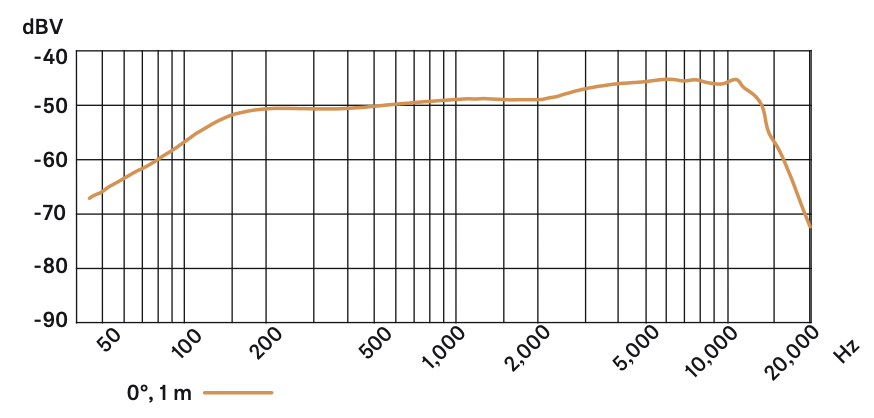
The frequency chart shows the E935 mic to have a smooth rising frequency response, lifting markedly at 2 kHz, before peaking with a little notch just above 10 kHz. From around 11 kHz there’s a decline.
Compared with the frequency chart of its predecessor, the E835, it’s smoother and brighter, with a similar overall frequency range.
E935 Sensitivity and impedance
As a dynamic mic, the Sennheiser E 935 is less sensitive when compared to a condenser mic. Low sensitivity is great for isolating the sound being picked up, as well as making it ideal for loud sound sources. This mic has the ability to handle a very high SPL.
And like most professional microphones, it has a low output impedance, stated as having a nominal impedance of 350 ohms (at 1 kHz). This makes it a good performer across long cable runs, and less susceptible to external interference.

E935 Sound quality
Sennheiser really seem to have got the balance right on the dynamic vocal mic. It’s an unashamedly bright microphone, but that shouldn’t be confused with harsh or brittle.
It imparts a balanced, warm sheen, exposing detail and clarity to a level more akin to a condenser mic. On my own low male (tenor/baritone) voice, the bass rolloff cleaned up the low end, while the extended high end added presence and vitality. It was a perfect match.
But it also performed admirably on female vocals, imparting a refined airiness, while tidying up any lower frequencies. A mic of this quality can also be used for recording or amplifying instruments. A fast transient response resulted in crisp sounding percussion, and sparkling acoustic guitar.
The Sennheiser E 935 is a versatile mic to have around in the studio. It’s a natural sounding mic, with a clean sound, and I’m sure it would sound great on other sound sources, such as brass, or for miking up a guitar cab.
As a naturally bright mic, the E935 won’t suit all situations. Every mic has its own characteristics, and it’s a matter of personal taste, and trying it out in various situations. I think this mic sounds fantastic, and certainly a good mic to have in your arsenal for both speech and vocals.
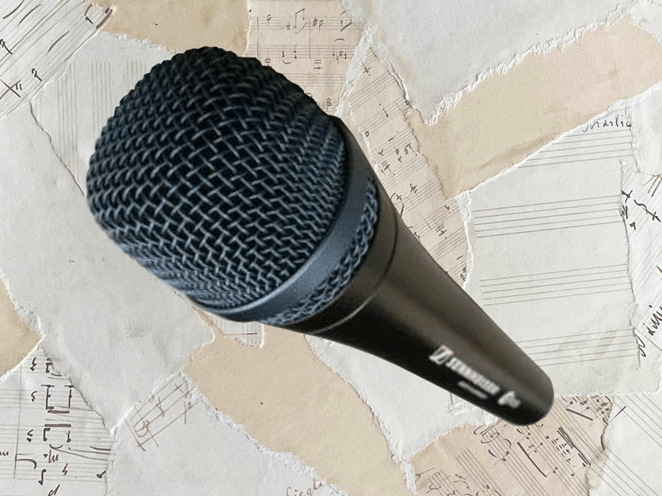
Sennheiser E935 in Performance
In use, any handling noise is barely audible. It also responds well to plosives – the pops and clicks caused by bursts of air. If you’re getting plosives while holding the mic, try experimenting with different mic positions.
Bringing the mic closer to the mouth resulted in a smooth proximity effect, gently increasing the bass frequencies for a fuller sound.
With the extended high frequency range, sibilance might be an issue for some voices. If so, try distancing yourself from the mic, or approaching the mic from a slightly different axis. Sibilance can also be corrected with EQ, or by making volume changes in the edit.
The Sennshieser E935 is a natural stage mic. It’s built like a tank, and the cardioid polar pattern means its good at rejecting sounds to the side and behind the microphone. It’s also highly resistant to feedback.
Sennheiser E935 vs Shure SM58
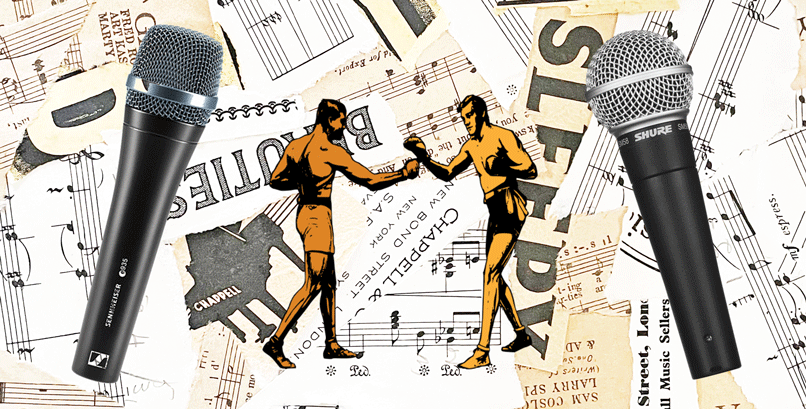
The Sennheiser E935 microphone is often compared to the Shure SM58.
The Shure SM58 is a well known and established vocal mic which has been around since 1966. It’s considered the industry standard for live and sometimes studio use.
The E935 and the SM58 are similarly constructed mics, and both popular for live vocals. Both the Shure SM58 and E935 have metal bodies and grilles. They’re both handheld dynamic cardioid vocal mics, with a similar overall frequency range. And they both excel in live performances, each with an internal shock mount and with excellent feedback rejection.
The biggest difference between the two mics is how they sound and how they look. The Shure SM58 is a ‘warm’ sounding mic, which means if the voice is already warm, or deep, the sound can get a bit congested in the lower frequencies. Though this would normally be corrected with equalisation. The lower frequencies of the SM58 will become even more pronounced the closer you are to it, as the proximity effect kicks in.
However, the Sennheiser E935 is an overall brighter sounding mic. Compared to the Shure SM58, you’re less likely to have to use EQ to get the vocals to stand out in a busy mix. It has a naturally clear and crisp sound which is well suited to vocals. Unlike the SM58, the E935 doesn’t respond so aggressively to the proximity effect, and can work well with vocalists who like to be (or need to be) close to the mic.
There’s no winner between the two – they have different characteristics which will suit different voices and situations. It could be said that the Sennheiser E835 is likely to sound the best ‘out of the box’, with no EQ.
Something to also consider is that the Sennheiser E 935 mic comes with a 10 year manufacturer’s warranty, whereas the Shure SM58 only has 2 years. In reality though, they’re both very well made mics, and if something was to go wrong, it would probably happen in the first couple of weeks.
Read the full Shure SM58 review here
E935 vs Shure Beta 58A
Another obvious comparison is between the Sennheiser E935 and the Shure Beta 58 A.
Both of these are excellent mics with very similar characteristics. My personal preference is for the E935, which has a slight edge in off axis rejection and high end definition.
Holding the E935
Where you hold the microphone in relation to your mouth can make a big difference in sound. Professional vocalists are always repositioning their mics to change the tone and add expression to their performance.
Always hold the vocal mic by the main body, and if there’s too much sibilance, try holding it slightly to the side.

When you have other instruments in close proximity and you just want the sound of the voice, it’s best to sing or speak directly into the mic. This will add more bass to the sound, due to the ‘proximity effect’. It’s an effect used by radio presenters to give them very deep voices.

For a more natural, balanced sound, hold the mic between 5 and 10 cm away from your mouth. There’ll be less of the proximity effect, and the mic will pick up more sounds from other instruments, and the acoustics of the room.

To bring in more of the room sound, and the instruments around you, hold the mic 10 cm or more away from your mouth. This is also a good position for any sudden loud notes, or to shape, and tail off a long note.
E935 vs E835
The Sennheiser E 935 dynamic vocal mic is an upgrade to the earlier, and less expensive E 835. They’re similar sizes, with the E835 slightly taller, but lighter.
On paper, they have similar specs, as bright dynamic mics with cardioid pick up patterns. The frequency charts show the E935 to have a smoother response, which you can hear in the sound.
What the frequency charts don’t convey is the fullness and depth of sound of the E935. It’s a noticeable upgrade to the E835, with a classier, more refined sound, and smooth high frequencies.
What else do you need?
With any vocal microphone, you’ll need:
- Microphone stand
Mic stands reduce any handling noise in the studio. Try a good quality boom stand, with a tripod base like the K&M 210/2
- XLR cable
If you want the best quality XLR cables, try these. Go for the shorter lengths where possible.
- Pop shield
This is to stop little bursts of air causing bassy pops on your studio recordings. You can easily make one of these out of stockings, or buy one here.
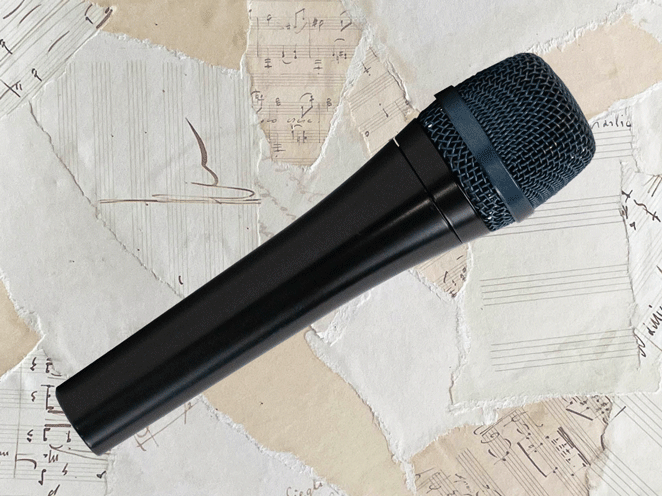
Conclusion
The Sennheiser E935 is a dynamic vocal mic with a superbly balanced sound. The frequency response is set up for live use, with a natural rolloff in the bass, and extended presence in the higher frequencies. This mic will cut through any mix with minimum equalisation.
It’s a bright mic without ever sounding harsh, and works well on a variety of instruments from acoustic guitar to percussion and louder instruments. A great mic to have in your arsenal for both live use and studio recordings.
Frequently Asked Questions
Does the Sennheiser E935 need phantom power?
No, the E935 is a dynamic mic, which means it doesn’t require any sort of power to work
What pick up pattern is the E935?
The Sennheiser E935 has a cardioid polar pattern, which picks up sound in a heart shape in front of the mic
How do I clean an E935 microphone?
Use a 70% alcohol solution sprayed onto a soft cloth to wipe down the body. To clean the head grille, twist it off, remove any foam and use a brush with 70% alcohol solution. Use warm water to clean the foam.
